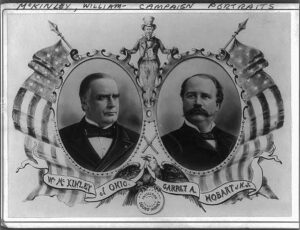
Introducing the 2021-2022 Webinars: An Interview with Jeremy Gypton
What can you learn from the webinars TAH will offer in the coming school year? Teacher Program Manager Jeremy Gypton explains.
How do TAH webinars help teachers and students?
The webinars feature the scholars who teach in our programs, talking about the resources we offer in our curated document collections. In each episode a panel of three professors—two with relevant expertise, plus a moderator—talk about the significance of one or more primary documents in the context of an event, movement, or controversy in our history. The moderator poses a question to start the discussion, later asking questions sent in by listeners. We hope the webinars encourage teachers to use primary documents in class. We hope they invite listeners into a deeper connection with us, exploring our document collections and attending our in-person seminars.
We offer ten Saturday webinars per school year, usually on the first weekend of the month, September through June. Each discusses a cluster of documents that illuminates a theme or era in our history. We also offer a Wednesday series (usually broadcasting on the 3rd Wednesday of the month), called “Documents in Detail.” In these we focus on a single document for one hour.
We’ve now archived 20 webinar episodes per year. The links to them, arranged by program and year, are all here.
Do the webinars feature familiar documents, or documents teachers may never have encountered?
We feature knowns and unknowns, which is a good thing. If you introduce an obscure document to listeners who don’t understand its context, they find it hard to assimilate this new information. So, we also feature familiar documents, illuminating ideas in them you may not have noticed. The familiar documents help you think about the documents that are new. It’s a good one-two punch.
Would you give an example of something a teacher can learn from listening to one of our webinars—something they would not learn by reading the documents on their own?
Two or three years ago, our theme for the Saturday webinars was “Great American Debates.” One webinar featured the debate between William Lloyd Garrison and Frederick Douglass over the best way to promote abolition. Douglass’s view of the US Constitution diverged sharply, over time, from Garrison’s view; he did not think it a slaveholder’s document and thought it important to work within the Constitutional order. Garrison rejected the Constitution, claiming it had institutionalized slavery. We set this webinar up as a debate between those two points of view.
As we always try to do, we put the panel together using one historian and one political scientist. Many of the political scientists in our program specialize in political theory, studying the ideas of leaders and political influencers. The political scientist examined Garrison’s view of the Constitution; the historian talked about how Garrison’s view informed the way he operationalized his abolition effort. Then they discussed Douglass’s ideas and operational approach.
My undergraduate studies didn’t prepare me to see the difference between the historical and the political science perspective, so this has been interesting. Another one of our “Great American Debates” focused on the views of Martin Luther King and Malcolm X. The political scientist examined their competing perspectives. The historian noted that behind the scenes King and Malcolm talked. Malcolm knew that his more militant views gave King some political cover for his nonviolent challenge to Jim Crow.
Reading documents, you’re always putting together a puzzle. An individual puzzle piece means nothing unless it can be connected to other pieces.
What challenges do teachers face when teaching with primary documents?
The big challenge is language. Take The Federalist. The ideas in each essay are not hard to understand. But late eighteenth-century literary English, which uses long sentences built of many clauses, usually with the main point coming at the end—that’s difficult. Or take a Supreme Court opinion. The opening paragraphs of Mapp v. Ohio are directed at an audience who understand legal terms and have a background in the other cases referenced.
Another big challenge is context. You can’t fully understand the significance of the “Cornerstone Speech” unless you know how it contradicts the post-Civil War Confederate account of their reasons for seceding. Nor will the 1912 Progressive Party platform explain the entire Progressive Movement. All three candidates in the 1912 election considered themselves Progressives, and you need to know something about why and how they differed. You need packing material to deliver historical content to students intact.
Then there is time. Until American history becomes a two-year course, and Government a full year course, this is a problem you must manage but cannot solve. When I was a teacher, I chose documents I thought would give students the most impactful experience. At certain points, we would slow down and carefully analyze a primary source. Afterwards, we had to accelerate. I gave students secondary sources or lectures that summarized events, until we reached the next topic we’d examine in depth.
My methods teacher told me you can teach history one of two ways. You can grade the road evenly, giving the same brief attention to every topic, or you can be a posthole digger, going deep in certain places and connecting each post with strong wire to the next. I always did the latter. I would rather my students work through documents to gain a deep appreciation of some of the problems in our history, while realizing that there is a lot more to learn about the topics we covered only superficially.
Working through documents, students develop analytical and historical thinking skills. Even if students forget the details of history, they’ll learn a way of thinking that will help them throughout their lives. Do the TAH webinars help teachers inculcate these skills?
I think so. Take the Wednesday series, Documents in Detail. For the 2021-22 school year, each one-hour episode will feature one document from one core document collection. The editors of each of the ten volumes selected one document they would not want readers to miss. Each will spend an hour talking with the other panelists about where, when, by whom, why, and how the document was written. They’ll also discuss how that document influenced later history, often starting conversations that later writers would continue.
The Saturday webinars will explore two particular document collections. In the fall, we’ll devote five episodes to the American Presidency volume. One fall episode will concern war powers and foreign policy, another the relationship between the executive and the Supreme Court. In spring, we’ll look at the Populists and Progressives volume. In each episode, we’ll address discussion questions from the appendix at the back of the volume. These questions are designed to help you analyze the documents individually and think about how each document responds to others in the volume.
What should teachers do before they listen to a webinar?
I hope they download a pdf of the volume to be discussed, or buy a paperback printed copy, and have it in hand as they listen. The pdfs are available free at the bookstore on our website, and we’ll give a link to the bookstore with each webinar. Ideally, you’ll read at least some of the documents in advance. After listening to the webinar, you’ll go back and read the documents in full. This will give you a really solid understanding of the documents themselves and how they have been understood over time.
Don’t think of the volumes as just collections of documents. Each collection offers other resources; make sure you download all four main sections. First, there’s the volume editor’s introduction, a four-to-five-page summary of the topic which is always outstanding. Next, you have the set of documents. Each comes with a short introduction that tells you where the document fits in the historical narrative you read in the volume introduction. Then in the back of the book, there are two or more appendices: a thematic table of contents, which organizes the documents by issue instead of chronologically, and study questions. You get two short paragraphs of questions for each document—no PhD can write just one question on any issue!
Which of next year’s webinars do you most look forward to?
They will all be good. I particularly enjoy John Moser, editor of the collection Great Depression and New Deal. His collection is great. The volume introduction summarizes and explains not only the events but also the ideas that motivated events. When you turn to the documents themselves, everything makes sense.
I’m really excited for next spring’s discussion of Populists and Progressives, edited by Jason Jividen. We don’t discuss contemporary politics at TAH, to avoid partisanship. Still, much of what we’re hearing about today originates in the writings of the populists and progressives. That’s really useful to know when talking about current events.
One last thing. Every month I get emails from people apologizing that although they registered for the webinar, they can’t make it. Don’t worry! We realize that our schedule may not fit with yours. But if you register for a webinar, you will get an email about a week later with a link to the podcast. There will also be a link to the documents we discussed.
We also have an archive of all the podcasts of all the webinars we’ve ever done; that can be found here.



